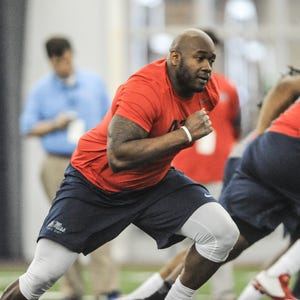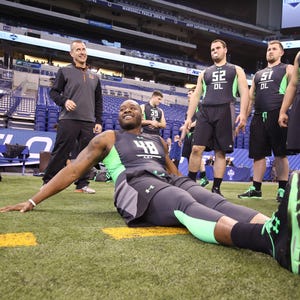Why drafting a tackle with first pick is risky for Titans – The Tennessean
If the Titans decide to select Ole Miss tackle Laremy Tunsil with the first overall pick in the NFL draft next month, they’d follow a path similar to one charted by many teams.
In the past decade, for instance, tackles have been taken 12 times with top-five picks and 18 times with top-10 picks.
But the results haven’t always played out the way teams hoped, especially in the past few seasons.
One big reason for the underwhelming performance of recent highly-touted tackles: College football has increasingly turned to spread offenses and passing attacks, so tackles aren’t necessarily prepared to make the transition to the NFL’s more balanced running/passing schemes.
That forces NFL evaluators to do more projection with tackles — guessing how they’ll fit into the NFL game — than they have to do at other positions.
All of that will be taken into account by the Titans, who sent a large contingent — including general manager Jon Robinson, coach Mike Mularkey and offensive line coach Russ Grimm — to watch Tunsil’s pro day at Ole Miss on Monday.
“Why certain tackles didn’t necessarily pan out … it could be a scheme-related thing,” Robinson said at the NFL combine in February. “It could be a coaching-related thing. I think every situation — positively and negatively — is really kind of its own unique situation and you have to evaluate it kind of in your own organization.”
Said Mularkey: “Offensive line has been harder (to evaluate) in recent years because of the offenses in college. It is a little different. You don’t see … guys coming off the ball, run blocking. You don’t see them in three-point stances. Rarely do you see that.”
Go back a decade in the draft and you see highly-picked tackles in three straight years make big contributions for their teams.
The Jets picked D’Brickashaw Ferguson (10-year starter, three Pro Bowls) fourth overall in 2006, the Browns took Joe Thomas (nine-year starter, six-time All Pro) first overall in 2007 and the Rams selected Jake Long (six-year starter, four Pro Bowls) first in 2008.
But things get a little shakier after that. Though there have been some top-10 hits — like Trent Williams with the Redskins in 2010 and Tyron Smith with the Cowboys in 2011 — there have also been plenty of misses and mediocre selections.
Some examples:
►In 2009, the Rams chose Baylor tackle Jason Smith with the second overall pick. He played just 48 NFL games before getting cut for the last time in 2013.
►In 2013, the Chiefs selected a tackle at No. 1 overall (Central Michigan’s Eric Fisher), the Jaguars selected a tackle at No. 2 (Texas A&M’s Luke Joeckel) and the Eagles selected a tackle at No. 4 (Oklahoma’s Lane Johnson). Fisher has surrendered 23 sacks in three seasons, Joeckel has given up 16 in the past two seasons and Johnson — probably the most successful of a bad trio so far — was flagged for 11 penalties last season.
►In 2014, the Rams took Auburn tackle Greg Robinson with the second overall pick. He averaged 12 penalties per year in his first two seasons.
►In 2015, the Redskins selected Iowa tackle Brandon Scherff with the fifth overall pick. He was moved to guard less than two weeks into training camp when it was clear he couldn’t keep up with speed rushers on the edge.
Some hits and misses are to be expected at every position, but NFL coaches and executives have expressed frustration at the increased difficulty of evaluating college offensive linemen, tackles in particular.
“You’ve got to factor in their development,” 49ers GM Trent Baalke said at the combine. “It’s going to take them a little longer to develop, especially in the run game, because they’re not asked to do it as much. There’s some things you have to look at differently now than you had to 10 years ago, because the college game is quite a bit different than the game we play, especially at the line of scrimmage.”
Cardinals coach Bruce Arians said today’s prospective NFL offensive linemen are better athletes than ever, but have worse fundamentals than ever.
“You’re drafting a guy right now coming out of some colleges that haven’t been in a three-point stance since high school, and you’re going to pay him a ton of money,” Arians said. “You have to teach him to get in a three-point stance and run-block. It’s fundamentals that we’re going back now and have to teach. We never had to teach it before.”
How does that translate to Tunsil and the Titans?
Tunsil played in a pass-first system at Ole Miss, lining up in a two-point stance far more often than a three-point stance. He gave up just two sacks in 29 career games, none in his suspension-shortened final season.
But he doesn’t see a problem readjusting to more three-point stance, which is used more frequently — especially in the run game — in the NFL.
“It won’t be difficult at all,” Tunsil told the NFL Network following his pro day on Monday. “In high school, I was in a three-point stance and I had to transition when I got to Ole Miss to a two-point stance. But when we used a tight end (at Ole Miss), I went back to a three-point stance.”
Ole Miss coach Hugh Freeze acknowledged that Tunsil might need to polish his run-blocking skills, but he doesn’t see it being a significant concern, nothing that would lead to some of the bad tackle evaluations of recent years.
“Because his second step gets in the ground faster than most human beings, he’s going to be a good run-blocker also,” Freeze said. “But I would ask also, is it more important to have that (run-game) polish or to protect that quarterback from that defensive end? There’s no one I have seen that’s as good as he is at doing that.”
Reach John Glennon at 615-259-8262 and on Twitter @glennonsports.




